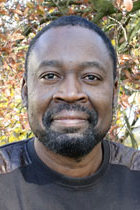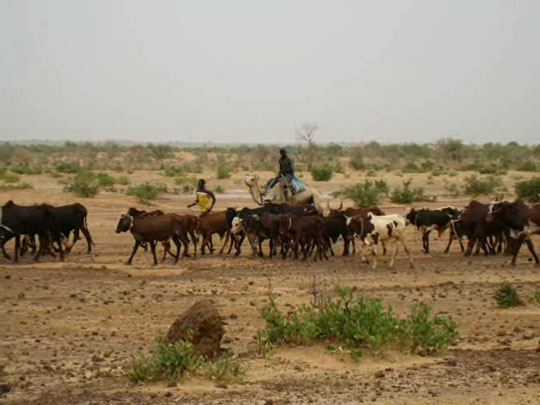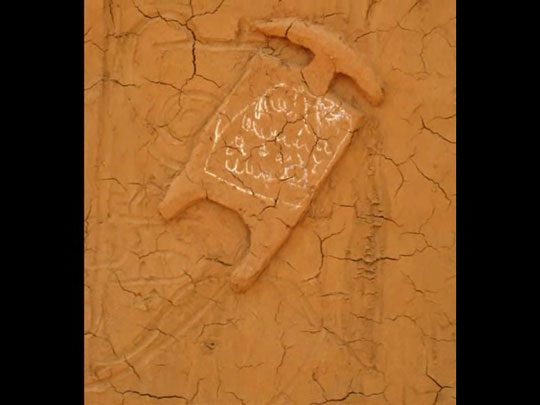Salafists and the Missing State in the Sahel


Rahmane Idrissa is a political scientist focusing on democratization and political Islam in Africa. Current projects are on the history of state formation in Africa, with a focus both on the modern (Niger) and premodern eras (Songhay).
In the 1960s, there was an African ambition to build modern states based on ‘national development’. But in the late 1980s, national development was dismissed - in most cases under compulsion from the international financial institutions. And without national development project, there are really no states in Africa, only regimes. In the Sahel, this paved the way for the establishment of the ‘Islamic state’.
Not long ago, I had a chat with a former prefect about the immense solitude of the work he did running a vast district in Niger’s Sahel-Sahara in the name of the state. Everything, he said, was so remote, every action painfully slow because of time, distance, isolation, and penury. ‘Thankfully,’ he sighed, ‘there were the traditional chiefs’ – the only eyes of the state over hundreds of kilometers around, especially in the sparsely populated Sahel-Sahara. There were gendarmerie brigades, a paramilitary police corps which was the (paltry) state effort at providing public security across wide stretches of land in which it was virtually absent. But more often than not, to reverse Voltaire’s quip about good government, these officers had their hands free for doing bad, and tied for doing good.
 Where is the State?
Where is the State?Another time, back in the mid-2000s, I found myself in the fields, deep in rural Gobir (the name of a historic region in central Niger), and was called out mockingly by a peasant, who asked me where the state was. I was dressed like a mushe (Hausa deformation of ‘monsieur’), i.e., a Western-educated man, and therefore, in his view, I must have been working, some way or another, for the state. His derision was over the fact that the state had abandoned rural development, and the shirt-and-trouser-wearing agricultural extension officers (mushanun gona, i.e., ‘the monsieurs of the fields’) were gone.
Violent crime in the countryside
It was about that time that I overheard, in a taxi, two rural migrants discussing in sober voices how much violent crime had become rampant in the part of the countryside they were from, and how little gomnoti (‘the government’) cared about that. They were speaking in Zarma, so their rustic homeland could not have been that far from the capital, which is essentially a Zarma city. People were easily killed over there and nothing would happen. I was especially troubled by the matter-of-factness with which they said those things. It meant they were not overstating.
Fulani militiamen
More recently, I interviewed former Fulani militiamen who had been active in the decade-long fight - with an unknown but doubtless important death toll - that had opposed them to Tuareg militia at the border between Niger and Mali, roughly, from the end of the 1990s to about 2010. One detail which they each mentioned was how they asked for help and redress at the gendarmerie at several turns - in vain. They wanted nothing more than for the state to get involved. Of course, these were fighters and militants, and their accounts of what happened are shaped by their cause. But I knew the many ways in which the state could be passive or absent, and that part of their tale, to me, was credible.
Modern economies and unified nations
These are vignettes that come from my experience in Niger, but I think they all could be true for most countries in Africa. They fit a certain history. In the 1960s-80s, there was an African ambition to build modern states based on national development. A modern economy would transform old, ‘backward’ (a popular word of the times) economic structures and modern government would fuse ancient cultures and communities into unified nations. In Niger, the first independent regime (1960-74) pledged to act as a ‘development administration’ and the second (1974-91) promised to turn the country into a ‘development society’. In Burkina Faso, the Sankarist regime of 1983-87 was essentially a form of radical or militant developmentalism.
Blueprint for society
Whatever the fate and failings of these projects, they did provide incentives for building state organizations, develop a blueprint for society, and cultivate an emotional attachment to the nation and the state. The Gobir peasant who was mocking me in 2006 remembered the activism of the national-development state. Some of the speeches of Seyni Kountché, the military ruler who promoted a ‘development society,’ are in Niger’s national lore, certainly the one in which he reprimanded the people of the small town of Loga, telling them their district was ‘a new Jamaica’. There is drollery here: Kountché was criticizing addiction to narcotics and alcohol in Loga and all the crime that these things led to, but the people of Loga, not knowing what ‘Jamaica’ was or stood for, thought he was complimenting them, and cheered him in exultation. But there is also the notion that Kountché’s government cared about security in the countryside, not just in urban areas. That was something which the abovementioned Fulani militiamen were fully convinced of. It was only after Kountché was dead, they insisted, that Malian Tuareg dared to enter Nigerien territory and steal their cattle.
The end of the national development project
In the late 1980s, national development was chucked - in most cases under compulsion from the international financial institutions. And without national development project, there are really no states in Africa, only regimes. The Princeton political scientist Jeffrey Herbst once claimed that rulers in Africa cannot take state work seriously, because states grow their functions under the threat of death and African states were not under any such threat. These views were inspired by another political scientist, Charles Tilly. Tilly has a theory that the nation-state was born on the countless battlefields of Europe, in the centuries between the fall of the Roman Empire and World War II. According to him, in the absence of the mortal menace from neighbours and rivals, there is little incentive for developing unpopular functions such as coercion, punishment, and the collection of tolls and levies, or devoting selfless energies to foster general prosperity. The concept of the national-development state put the lie to the notion that states are built mainly for military reasons, showing the welfare of the population may actually be an incentive in itself. But Tilly’s theory seems supported by what happened after that internal incentive was removed: states virtually stopped to ‘form’ in much of Africa. Many entered a kind of political recession (the era of ‘weak’ or ‘fragile states’). And in the Sahel, an alternative started to gain credence - the ‘Islamic state’.

Establishing an ‘Islamic state’
The idea of establishing an ‘Islamic state’ existed in certain circles in the Sahel as far back as the 1940s. It got a boost in the 1980s, from the Iranian Revolution and the less well-known Wahhabi Revolution of Saudi Arabia (a state-led embrace of radical Wahhabism). But it is the end of the national-development state that really opened the way for the ‘Islamists,’ now wedded to the grim theology of Salafism. In the 1990s and 2000s, Salafist ideologues became influential actors in all the countries of the Sahel and their vision of Islam went mainstream. In northern Nigeria, this led to the codification of Sharia. Elsewhere, secularism took a beating and hearts and minds were captured. But this (non-violent) success was essentially urban. The chief ideologues were urbanites, the foot soldiers were members of the urban toiling classes (‘the informal economy’), and the target was the state, which - as my observations above suggest - was almost exclusively an urban institution.
Women covered from head to toe
In a book I published in 2017, I studied this rise of political Salafism in five Sahelian countries and concluded that it could not reach its goal. I became more convinced of this when I noticed that the violence associated with Salafism (Boko Haram, e.g.), and which kills Muslims more than anyone, is leading slowly but surely to a blowback in the towns and cities of the Sahel. The rural areas did not look like a concern. Although they arguably suffer more from the fall of developmentalism, they were firmly dominated by Sufi Islam, and many Salafist prescriptions went against the grain of life there. For instance, how could a rural economy so reliant on women working under a blazing sun accept to see them covered from head to toe in heavy black garments?
Collapse of Kaddafi’s regime
The string of events triggered by the destruction of Kaddafi’s regime in Libya in 2011 changed this. By then, Salafists had established a stronghold in Mali’s Sahel-Sahara, but they were mostly foreigners, holdovers from the bloody Algerian civil war of the 1990s who had found a sanctuary in the Malian desert. They remained relevant - and wealthy - by abducting Westerners in the Sahel and offering protection racket to the myriad traffics that crisscrossed the western and central Sahara. The collapse of Libya proved a boon. Kaddafi was a Sufi supporter and no lover of Salafists, especially Algerian Salafists (they might be in cahoots with the military who ruled Algeria, he suspected). Now he was gone and his huge stockpile of armament was available to any good bidder. And they were wealthy. They rapidly took control of the war started by Tuareg rebels in Mali in early 2012, and the Malian army - derelict, as were other organs of the state - was no match to their firepower and their knowledge of the grounds, especially since they were allied with Salafized Malians from the northern regions. These fateful Malian events lit a fire that found ready tinder in the many issues of the rural Sahel: the lack of development, of security, of justice - and the absence of the state. Indeed, if certain communities participate more in the Salafist war than others, it is a fact that the conflicts rage most where the state was most absent: northern and central Mali above Segu, northern and eastern Burkina Faso.
Much blood shed
One could muse that, urban Salafists having failed in the project of conquering the state from the inside, from within urban society, rural Salafists are now trying to conquer it from the outside, by ousting it from the rural areas - at least certain rural areas. Clearly, that’s the strategy. Under present conditions, I don’t see how it could succeed. Just as in the urban areas, the Salafists will hit a wall here too, sooner or later. But in the meantime, much time will have been wasted, much blood will have been shed, and much energies misspent.
Yet, if Herbst and Tilly are right, then perhaps here is an opportunity for the elites in the countries concerned to start taking state work seriously again.
Photo credits: All photos by Rahmane Idrissa.
Top photo (header): Mosque in a village in Northern Mali.
Top photo (header): Mosque in a village in Northern Mali.
Upper photo: cows in a field near Magaria, Central Niger.
Lower photo: Clay relief sculpture representing the slate used by Koranic school students.
This post has been written for the ASCL Africanist Blog. Would you like to stay updated on new blog posts? Subscribe here! Would you like to comment? Please do! The ASCL reserves the right to edit, shorten or reject submitted comments.
Read the former ASCL Africanist Blog post ‘The elusive Sahel Caliphate’, written by Mirjam de Bruijn and Han van Dijk.
Tags
Salafism
Islamic state
national development
weak states
fragile states
rural areas
justice
Fulani
Tuaregs
Niger
Mali
Sahel
Sahara
Libya
Algeria
Posted on 26 November 2019, last modified on 26 November 2019


Add new comment